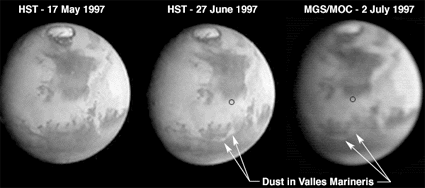![]()
![]()
 |
Download GIF Image (8 k)
MGS Orbiter Camera Release / ID Number:
MOC2-1 / 552348805.20
This image is the first view of Mars taken by the Mars Orbiter Camera (MOC) science instrument onboard the Surveyor spacecraft. The photograph was acquired the afternoon of 2 July 1997 when Surveyor was 17.2 million kilometers (10.7 million miles) and 72 prior to arrival at Mars. At this distance, the MOC's resolution is about 64 km per picture element, and the 6,800 km (4,200 mile) diameter planet is 105 pixels across.
The observation was designed to show the Mars Pathfinder landing site (19.4N, 33.1W) approximately 48 hours prior to landing. The image shows the north polar cap of Mars at the top of the image, the dark feature Acidalia Planitia in the center with the brighter Chryse plain immediately beneath it, and the highland areas along the Martian equator including the canyons of the Valles Marineris (which are bright in this image owing to atmospheric dust). The dark features Terra Meridiani and Terra Sabaea can be seen at the 4 o'clock position, and the south polar hood (atmospheric fog and hazes) can be seen at the bottom of the image.
The Mars Orbiter Camera is a duplicate of one of the 6 instruments originally developed for the Mars Observer mission. It was built and is operated under contract to JPL by an industry/university team led by Malin Space Science Systems in San Diego, CA.
 |
Download GIF Image (88 k)
MGS Orbiter Camera Release:
MOC2-2
This mosaic shows a comparison of images taken by the Hubble Space Telescope's Wide Field/Planetary Camera (HST/WFPC) and the Mars Orbiter Camera (MOC) onboard the Surveyor (MGS) spacecraft. The images show the progress of a regional dust storm within the Valles Marineris canyons on Mars.
The first HST image (left), taken in mid-May, shows no dust within the canyons. The most recent HST image (center), taken on 27 June in support of the Mars Pathfinder landing activities, shows a dust storm filling part of the canyon system and extending into the chaotic terrains at the eastern end of the canyons. The MGS/MOC image (right), acquired on 2 July, shows that bright dust continues to fill the valleys. However, it does not appear to have moved significantly north of the previously observed position, suggesting that the storm remains confined to the the canyon region, and does not appear to directly threaten the Pathfinder landing site (small black circle).
The HST images shown here have been reduced in scale to match that of the MGS/MOC image. Although the HST is 10 times farther from Mars than MGS, its images are sharper because its resolving power is 15 times better than the MOC, and the light gathering area is almost 50 times greater. However, MGS is presently 45,000 times farther from Mars than it will be when the MOC begins its primary photography mission. At 400 km above the Martian surface, the MOC wide angle camera will collect daily images at a resolution of 7.5 km/pixel, compared to HST's best of about 20 km/pixel. The narrow angle camera will observe portions of Mars at better than 1.5 m/pixel.
The Mars Orbiter Camera is a duplicate of one of the 6 instruments originally developed for the Mars Observer mission. It was built and is operated under contract to JPL by an industry/university team led by Malin Space Science Systems in San Diego, CA.